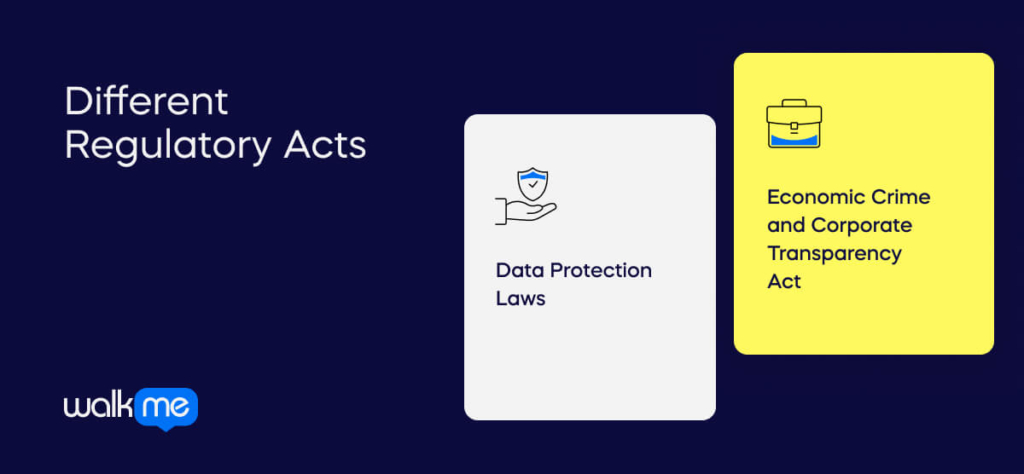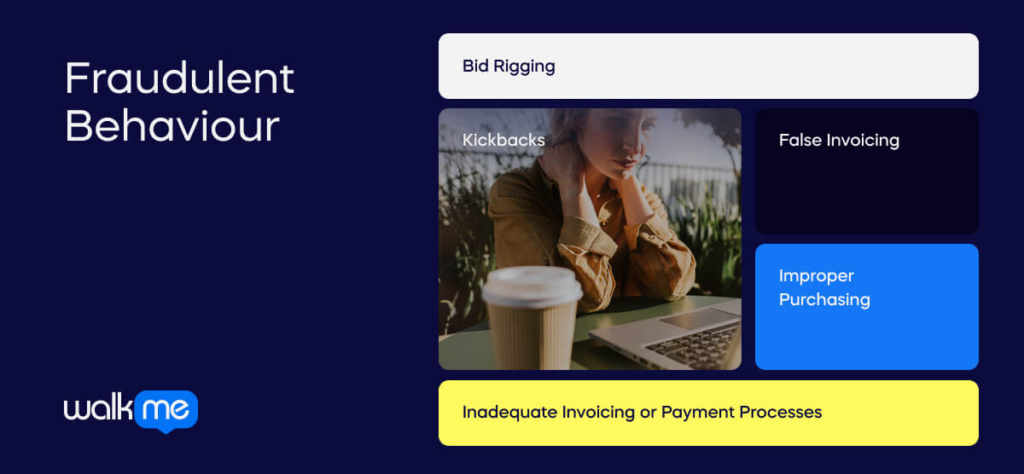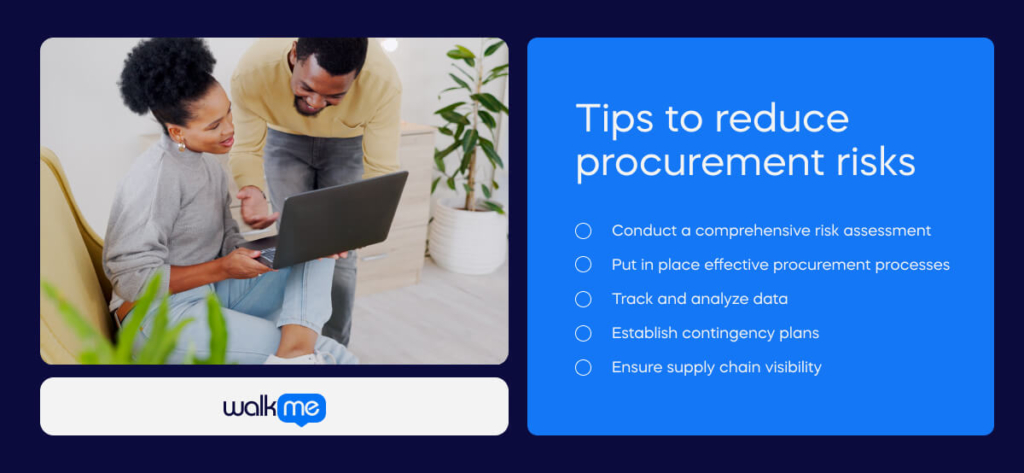Procurement is essential for company operations. It enables value for money by improving operational efficiency and reducing purchasing risks.
Still, including third parties in business transformation comes with a certain level of risk.
Procurement leaders usually aim to select suppliers with minimal risks. When evaluating potential suppliers, you should identify and assess different procurement risks.
In this article, we will explore:
- What procurement risk is
- Why preventing procurement risks is important
- The most important types of procurement risks you need to mitigate
- Tips to help reduce procurement risks
What are procurement risks?
Procurement risks involve situations where businesses cannot obtain necessary products, resources, or services. Failing to identify these risks could lead to undependable suppliers, missing deadlines, and unnecessary budget extensions.
Effective management of procurement risks is vital for a business’s health and revenue because they affect the supply chain. Additionally, businesses may encounter risks within the procurement process from vendors or partners that are beyond their control.
Why preventing procurement risks is important
Procurement’s primary purpose is to acquire goods and services. Yet its core lies in finding the right balance between risk and reward to enhance savings and value through risk management.
Regardless of scale, every purchase carries transactional data and various risk factors, such as vendor reliability, product quality, and legal compliance. These risks can affect all parts of the organization.
A procurement risk strategy should prioritize mitigating risks that impact the entire organization to improve efficiency and effectiveness.
15 common types of procurement risks to reduce
To create a plan for mitigating procurement risks, you must understand common risks faced by businesses:
- Cyber risk
Vendors without strong cybersecurity measures may face cyber risks. This makes them susceptible to attacks that could compromise data, cause financial losses, or damage their reputation. Routine vendor cyber checks are essential to pinpoint these risks.
- Regulatory risk

The risks associated with regulatory compliance in vendor management involve ensuring that vendors follow relevant laws and regulations. These include data protection and the Economic Crime and Corporate Transparency Act.
Vendors must establish adequate security measures and incident response plans. Reviewing vendor management policies is essential to confirm their alignment with these risks.
- Economic risk
Economic risk entails evaluating how market conditions or economic factors impact a supplier relationship. If you switch to a new growth model because of changing market dynamics, you might find that your current vendor doesn’t have the required features to support this change.
Furthermore, market changes could influence your vendor’s decision-making. They may downplay a feature set you depend on to focus on a larger audience. It could also focus on developing and supporting a different product.
When faced with such situations, it may be necessary to reassess vendor sourcing. You could do this to find a supplier who aligns with organizational requirements.
- Credit risk
Procurement credit risks involve potential financial losses if a vendor cannot fulfill contractual obligations due to financial constraints. These situations can occur when vendors have low credit scores, suggesting instability. It can also occur when they request expedited payment terms, indicating cash flow challenges.

You can gather and analyze credit information during the vendor onboarding phases. Procurement departments should test vendors’ financial stability and incorporate these risks into their decision-making process. This evaluation should not be confined to a single moment but continuous. The role of an automation platform in this process is vital.
- Vendor management risk
Vendor management oversees communication channels, order processing, supplier status, and important data and business metrics necessary for successful procurement.
The manual tracking milestones and activities with vendors and suppliers can add complexity to vendor relationships. The importance of leveraging digital and analytics solutions has increased after the pandemic. These solutions enable companies to track and analyze opportunities and challenges. They do this by eliminating fragmented data across various systems.
- Resistance to digital transformation
Many businesses adopt digital solutions to scale and conduct thorough spend analysis on procurement methods to avoid risk.
However, you cannot achieve digitization without proper training, onboarding, and an easy-to-use interface.
Third parties may not be willing to trust your technology with their data or invest time in ramping up a new platform.
This is where it becomes important to use digital adoption platforms to speed up onboarding. It does this by removing any guesswork and siloes while using new systems.
- Financial risk
One of the main financial risks in procurement operations is fraud. This can potentially occur at any stage, from the payment proposal. Examples of fraudulent activities include bid rigging, kickbacks, and false invoicing. Moreover, poor fund management can lead to financial risks through improper purchasing, invoicing, or payment processes.

Buying items or services without proper approval can cause budget overruns or unauthorized spending. Depending only on complex spreadsheets for gathering and organizing data impedes well-informed spending choices. It also leads to delays and inefficiencies in financial management.
Furthermore, the lack of automation in document management amplifies the potential for errors. Clear policies and procedures are necessary to address these challenges. It could be related to procurement processes, authorization levels, and approval mechanisms. Implementing a centralized procurement system enhances monitoring capabilities and streamlines purchasing activities.
- Planning risk
Inadequate planning creates a major procurement risk. This then leads to frustration and headaches for everyone involved. It can also lead to missed opportunities, decreased efficiency, unexpected costs, and tarnished customer reputation. To address these problems, establish achievable objectives. You should take a conservative approach to planning and prepare contingency strategies.
Is plan effectiveness monitored, including meeting deadlines, maintaining budgets, and ensuring employee satisfaction? If not, change the plan. To achieve success, focus on reporting, accountability, and transparency.
- Environment, Social and Governance (ESG) risk

ESG factors are now a major focus for businesses.
The main focus is on ethical sourcing practices. Companies should closely examine suppliers. You should consider human rights, environmental sustainability, and political honesty. Not adhering to ESG standards can harm a company’s reputation.
To minimize risks, organizations must check the ESG impact of supplier relationships and take steps to prevent potential problems. This could entail conducting comprehensive due diligence on potential partners.
It could also involve implementing a code of conduct for all suppliers. You could also establish stringent supplier management policies. Businesses can protect themselves from costly procurement risks in the future by being proactive and staying updated on trends and regulations.
- Short of effective talent
There are various manifestations of talent shortage risks in the procurement process. The increased demand for certain procurement professionals could result in salaries surpassing budget constraints. Insufficient staffing may cause delays and inefficiencies in procurement. Also, unqualified employees can lead to more errors and complications.
Moreover, complex application and interview processes may discourage qualified candidates. Reduce risks by implementing effective hiring processes. These should simplify employee onboarding and attract skilled procurement professionals.
- Strategic risk
Strategic risks are a collection of challenges that can occur due to decisions made by senior management. Examples include purchasing inappropriate goods or services and not evaluating and mitigating supplier risks. It also includes inaccurate predictions of demand and market analysis.
Issues like these frequently occur when process visibility and disorganized procurement procedures hinder data collection and analysis. As a result, businesses might miss opportunities to cut costs, improve workflow, and grow overall.
You can reduce this risk by centralizing all procurement data and making it easily accessible. This will help streamline decision-making and allow for accurate forecasting.
- Supply chain disruption risk
Supply chain disruptions can occur due to factors like extreme weather events and trade conflicts. They can also occur due to geopolitical shifts such as Brexit.
Mitigating risks involves procurement departments giving priority to supplier diversification. This allows the maintenance of backup secondary suppliers. It is also important for them to identify and assess suppliers most at risk of disruptions. This then helps develop preemptive strategies.
- Human error risk

The potential for human error is high. This is particularly true for businesses still managing procure-to-pay processes manually.
Hand-written forms, purchase orders (POs), and invoices are more prone to human error. There is an added risk of paper copies being lost. This further elevates the potential for invoice fraud.
Human error can result in documents riddled with mistakes and the loss of crucial forms or data. This risk then increases the invoice approval cycle time.
This inefficiency forces companies to spend more time to rectify errors.
Reduce human error in the procurement department by adopting procure-to-pay software systems.
- Reputational risk
Reputational risk occurs when your brand image is tarnished by negative publicity caused by a supplier’s actions. To prevent this, it’s crucial to pick partners whose values align with yours. Care about environmental sustainability? Choose companies that are focused on reducing their carbon footprint.
- Operational risk
The complex nature of procurement creates operational risks, which can affect business continuity, profitability, and reputation. The key to managing these risks is to tackle specific challenges.
Delays and errors can occur due to complex approval processes, manual tasks, and outdated systems. However, you can improve efficiency by streamlining workflows and adopting digital technology.
Procurement teams working in isolation might miss out on important insights stuck in data silos. By dismantling these silos and promoting collaboration, you can improve decision-making.
Unexpected events in nature, politics, or the economy can disrupt supply chains. To mitigate these risks, it’s important to diversify suppliers. You should also have strong risk management strategies in place.
Navigating intricate regulations and ethical standards is crucial. You can do this to avoid penalties and damage to your reputation. It is also vital to stay informed and enforce effective compliance programs.
Furthermore, a lack of understanding about supplier performance and spending patterns can result in unexpected outcomes. Real-time analytics and forecasting tools can enhance visibility and decision-making.
Tips to reduce procurement risks

Here are some tips to help you cut procurement risks during the procurement process:
Conduct a comprehensive risk assessment
Every organization must conduct a comprehensive risk assessment of its procurement process. This evaluation can help identify potential vulnerabilities. This can be in relation to fraud, waste, and reputational risks.
Organizations can create and execute risk assessment plans by collaborating with third-party risk management professionals. These plans play a key role in minimizing exposure to potential problem areas.
Put in place effective procurement processes
Efficient and secure procurement processes are vital for organizational success. Organizations should start by creating a map of their current processes. This can help businesses understand how technology could help with efficiency.
Organizations can streamline their procurement workflows by simplifying and optimizing processes. Also, automation technology can lead to an increase in accuracy and speed. This can optimize procurement operations.
Track and analyze data
Continuous monitoring and analysis of purchase data provide valuable insights into usage patterns. Tracking key metrics and performance indicators is vital for evaluating supplier performance. This ensures that it aligns with the overarching goals of the company.
Organizations should focus on user-friendly platforms that integrate with existing systems. These platforms make migration easy and only need minimal employee training, improving efficiency.
Establish contingency plans
Preparing for unforeseen disruptions is crucial to maintaining operational continuity. By conducting due diligence, organizations can ensure they have backup suppliers as alternative options. These contingency plans ensure a smooth transition. They also reduce risks in case of vendor non-compliance or closure.
Ensure supply chain visibility
Maintaining visibility throughout the supply chain is essential for prompt issue resolution. Organizations need to track supplier finances and track inventory movement.
By taking this approach, organizations can address issues at different operational stages. Comprehensive supply chain visibility is crucial for managing risks in procurement operations.
Next steps for minimizing procurement risks
Clear risk identification is the first step toward effective procurement risk management. You must use suitable data management tools to measure and track these risks. Incorporating a strong risk management framework into your procurement strategy affects outcomes. This is the difference between success and failure, or even financial ruin.
Transparent and communicative business practices are important for establishing client trust and respect. Enable your team to access contract terms, client performance, and payment activities. This can ensure prompt payments, precise success assessment, and conflict resolution without assumptions.
Standardization becomes difficult due to the need for manual monitoring and tracking. By adopting a data-driven approach to procurement, teams can access reliable information.


